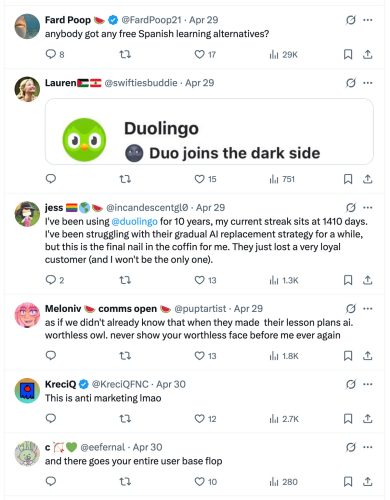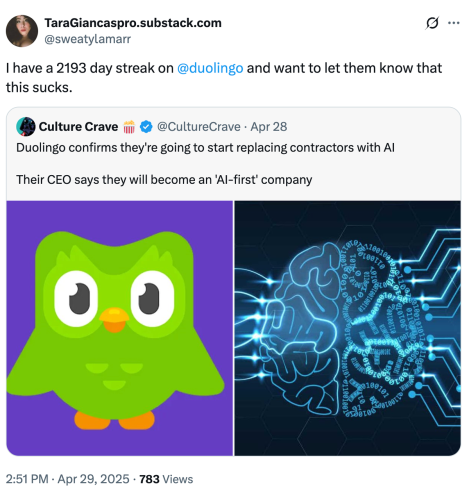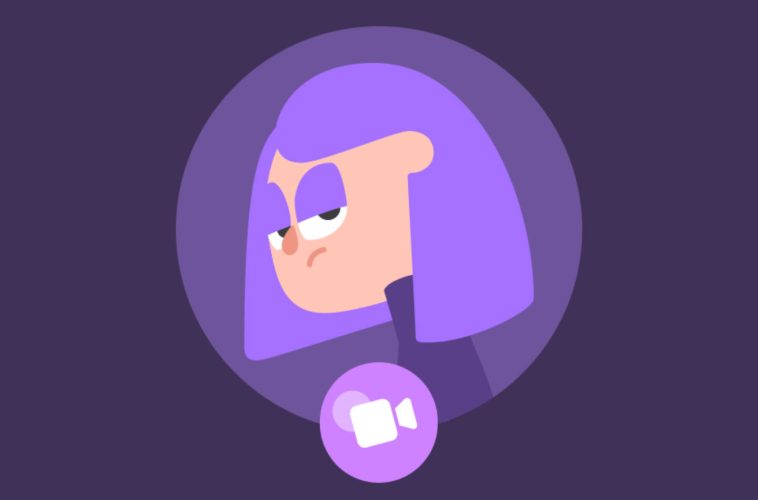As Duolingo Turns to AI, Some Users Say Language App Has Joined ‘The Dark Side’
The company behind the wildly popular phenomenon says artificial intelligence has helped it build 150 new courses in a year. But at what cost?
By Greg Toppo | June 3, 2025Can artificial intelligence push the world’s most well-known language learning app to new heights — or will it lower quality and turn off loyal customers upset that language teachers’ jobs are being outsourced to bots?
That’s a question Duolingo is grappling with this spring after an all-hands email published in April to the job posting site LinkedIn revealed that the Pittsburgh-based company will become “AI-first,” largely doing away with the human contractors who develop courses. In the meantime, it’ll focus on using AI to run basic functions of its app, such as a new chatbot that engages users in live conversations in hundreds of languages.
It’s perhaps the most extensive shift into AI to date for an education provider, representing a huge bet on the reliability of large language models that publicly debuted less than three years ago — and which remain notorious for regular lapses into unreliability.
Founded in 2011 at Carnegie Mellon University, Duolingo is now worth $23.6 billion. Last year it boasted more than 103 million monthly active users. Its largest U.S. user group is under 18, but users span all ages. In 2016, Duolingo launched a free app for schools.
Developers needed 12 years to develop the first 100 courses for its massively popular mobile phone app, known by its ubiquitous green owl mascot Duo. Using AI, they created nearly 150 new courses in just the past year, founder and CEO Luis von Ahn said in the email. Just as developing a mobile app in 2012 helped the company grow exponentially, he predicted the shift toward AI will prove equally significant.
To teach well, we need to create a massive amount of content, and doing that manually doesn’t scale.
Luis von Ahn, Duolingo CEO
“To teach well, we need to create a massive amount of content, and doing that manually doesn’t scale,” von Ahn said in the email. Expanding without AI would take decades. “We owe it to our learners to get them this content ASAP.”
To do so, Duolingo will gradually stop using human contractors “to do work that AI can handle.”
While turning to AI may well accelerate course development, the move is angering veteran users who predict that replacing humans with bots will weaken the app with inaccurate, lower-quality content. In protest, many have threatened to delete it from their phones.
On Blue Sky, one user wrote, “Just dropped a 1 star review, f*** Duolingo for doing this.”
On X, a user wrote simply, “Duo joins the dark side.”

Duolingo did not immediately respond to a request from The 74 for comment. In a May 2 video interview with Bloomberg News, von Ahn attributed the blowup among users to a “misunderstanding,” but his explanation for the move confirmed that the company will largely replace human course developers with AI, as users fear.
“What we said is that whenever there is some job that can be done by AI, and it can be done really well, then we’re unlikely to hire contractors to do that job,” he said.
The announced policy won’t affect full-time employees, he said.
Duolingo employs about 900 people and continues to grow as the company adds offerings in math, music and other subjects, Bozena Pajak, Duolingo’s vice president of learning, noted recently.
But AI is forcing the company to ask essential questions, she said during a talk at the 2025 ASU+GSV Summit in April. “We’re going to continue hiring people, but we’re going to be a little bit more intentional-thinking about what roles really are going to impact our business.”
We're going to continue hiring people, but we're going to be a little bit more intentional-thinking about what roles really are going to impact our business.
Bozena Pajak, Duolingo’s vice president of learning
So the company will focus on “people who are very versatile” and who are comfortable and “excited” about AI, she said.
Cem Kansu, Duolingo’s head of product, told an interviewer last November that AI has been “transformational,” helping the company quickly create new content and build interactive features.
The whole machine of content creation at Duolingo has gained insane speed in the past two years.
Cem Kansu, Duolingo’s head of product
“The whole machine of content creation at Duolingo has gained insane speed in the past two years.”
‘Guess I’ll find different ways to learn’
In a video interview last month with the tech podcast No Priors, von Ahn said Duolingo originally created a lot of content “half by hand, half automatically,” making for a slow process.
AI, von Ahn said in the April memo, would help employees “focus on creative work and real problems, not repetitive tasks.”
The explanation may be too little too late for many users, who said the move to largely get rid of contractors who create courses was prompting them to stop using Duolingo, in many cases sacrificing valuable “streaks” of hundreds or thousands of consecutive days spent using the app.
One quipped, “Well I just ended my family plan subscription & killed my 530 day streak. Guess I’ll find different ways to learn.” He added a waving hand emoji.
Another wrote, “In my opinion it is now complete rubbish — I have let go of my nearly 900 day streak and unsubscribed — bring back humans.”
The company already trimmed its contractor workforce in January using AI, when it “offboarded” 10% of them, a company spokesman told Bloomberg. “We just no longer need as many people to do the type of work some of these contractors were doing.”

Andy Lucchesi, an AI education specialist and language course designer based in Spain, said language teachers may rightly worry about the loss of nuance when AI is generating lessons. “Language isn’t only structure — it’s emotion, culture and tone,” she wrote in a letter to her students that she shared with The 74. “AI doesn’t always grasp that.”
But the move, Lucchesi said, offers a clear boost for access: “A student in rural India can now learn English with support in Hindi, without waiting for a local instructor or textbook.”
And while the benefits to “endless conversation practice” and pronunciation feedback are clear, she said, that may only go so far. “Learning a language is social, emotional, and cultural. Motivation often comes from connection — a teacher who encourages you, a classmate who laughs with you, a shared context that makes words meaningful. AI can support that, but it can’t replace it.”
Language isn’t only structure — it’s emotion, culture and tone. AI doesn’t always grasp that.
Andy Lucchesi, AI education specialist
Benjamin Riley, a well-known AI-in-education skeptic, said it makes sense that generative AI would be incorporated by a language app, since Google engineers developed the breakthrough technology underlying it, known as the Transformer, while working on translating human language.
“It’s a natural fit,” he said. “But the bigger question might be this: In a world where AI might — emphasis on might — be able to simultaneously translate between any two human languages, why would people bother to become bilingual at all?”
He invoked the science-fiction fantasy of the Babel Fish, a universal translator featured in The Hitchhiker’s Guide to the Galaxy, which now seems “within reach,” he said, given current AI developments.
“The optimist might see this as reducing cross-cultural friction because we can all talk to one another. The pessimist might worry about languages dying because they aren’t prevalent enough to be fed into AI training models, and that something important will be lost if humans are monolingual.”
In a world where AI might be able to simultaneously translate between any two human languages, why would people bother to become bilingual at all?
Benjamin Riley, AI skeptic
Kansu, Duolingo’s head of product, said he’s not worried about AI making language learning obsolete, since even with the best translation service, workers must still wait for it to process speaking. “Would you want to work with someone that has a 15-second lag in every interaction? I don’t think humans want that today.”
Chatting with Lily
At the ASU+GSV summit, Pajak, Duolingo’s vice president of learning, told an interviewer that large language models, or LLMs, made possible a new feature that allows users to converse in many languages with a chatbot named Lily. “I’m very excited about it. I use it almost every day to practice my Italian,” she said.

A former language teacher, Pajak said that back-and-forth is key to learning a language. “You want to actually be able to speak” to improve.
User enthusiasm for the chats with Lily helped drive a 50% rise in subscriptions, the company said recently, noting that the bot is included in Duolingo’s most expensive tier.
John Bailey, a nonresident senior fellow at the conservative American Enterprise Institute who specializes in AI, said Duolingo’s move seems smart. “Leaning into ‘AI-first’ is just an acknowledgement that these capabilities are only going to get better and cheaper over time,” he said.
In the interview last month, von Ahn predicted that education systems will change over the next few years to offer better, more reliable feedback to students. AI, he said, will scale good teaching.
“There are extremely good teachers for sure, but there’s not very many of them — and certainly most everybody in the world doesn’t have access to a good one.”
Get stories like these delivered straight to your inbox. Sign up for The 74 Newsletter






